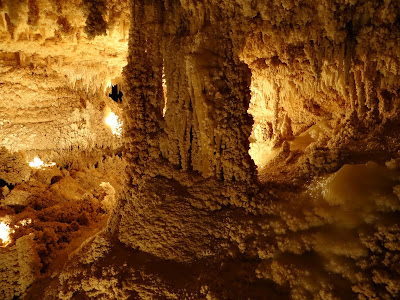Above is a detail of a 32-shaft design I'm working on called "Dreaming in Color." It has a 4-color Echo threading and uses 2 additional colors in the weft. I guess that makes it 6-color double weave.
Anyhow, that's the beauty of designing for double weave on Echo threadings: With the right tieup, you can create a magical array of shifting colors. And, if you want to take your creation a step further, you can add a weft with a crepe or shrinking yarn to achieve a dimensional weave.
In order to achieve texture with these designs, you have to look for "pockets" in the structure. (With some tieups and treadlings, you'll get integrated double weave rather than pockets, meaning that the two layers are interlaced.) To see these pockets and/or interlacements, you have to look at the "structure view" in Fiberworks. Here's what the first design looks like in that simulation.
This is kind of a dizzying array of black and white graphics -- but if you look at it closely, you'll see stair-like lines in two sections. These indicate "pockets" in your cloth, meaning that in these sections you'll be weaving two layers of double weave. Also, the sections of both upside down and rightside up "T" shapes indicate pockets as well. (These patterns are discussed on page 170 of Marian Stubenitsky's book, Echo and Iris. As far as I'm concerned, this book has a lifetime's worth of learning in it, not to mention the beauty of the patterns themselves.)
And what about that unusual tieup?
This is the same tieup, in reverse, that Stubenitsky uses on page 175 of Echo and Iris.
To understand what is happening, it's helpful to divide it into upper and lower layers, like this:
As far as good designs are concerned: I'm not sure I'm there yet, wherever that may be, but I think I'm moving in the right direction.
Detail of another design
All of this is in preparation for a new workshop I'm developing, "Echo on the Double," that will focus solely on 4-color and 6-color double-weave designs on Echo threadings. For people who love to play with color, as I do, these techniques have great possibilities.
Putting it all together is a challenge, of course: combining a strong design line with an interesting tieup and treadling, learning how colors blend and play out, taking care to get the right sett and beat and, ultimately, winding up with a good hand for the cloth.
I hesitate to admit how many designs I create before achieving one that really works! Here's one, below, that I'm on the fence about. It uses the same design line for the treadling as for the threading -- not quite tromp as writ, because the threading is a 4-end parallel while the treadling is a 2-end parallel.
I kind of like the eccentricity of this pattern. The quirky, linear motifs kind of remind me of cave columns, where stalactites and stalagmites meet. Can you detect them?
Photo: Alex Demas, USGS, public domain
Unlike many of my blog posts, this one is more just thinking out loud or, as I call this design I'm working on, "Dreaming in Color." There will be many variations and probably many more patterns before anything goes on the loom....
Thanks for reading!











